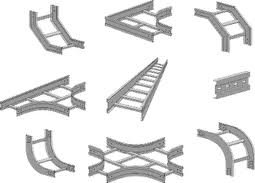 The cable tray is meant to prop up insulated cables for communication and power distribution. Cables are mounted on the tray, rather than placed inside a pipe. It can be likened to the structural cog of the building’s electrical layout, as it protects the cables both inside and outside. Wires are organized properly so wire maintenance is easier.
The cable tray is meant to prop up insulated cables for communication and power distribution. Cables are mounted on the tray, rather than placed inside a pipe. It can be likened to the structural cog of the building’s electrical layout, as it protects the cables both inside and outside. Wires are organized properly so wire maintenance is easier.
A cable tray facilitates the process of tracking down where wires come from for repairs, and also creates effective fire sealing between wall panels.
Since it protects cables, it reduces the risk of electric shock among installation and maintenance service personnel. The common varieties are usually fabricated from stainless or galvanized steel, aluminum, or plastic supported by fiber glass.
You can choose from multiple cable tray designs. The most ordinary is the ladder-type cable tray, which may be utilized for a longer duration even with the absence of support brackets. These trays facilitate more ventilation for wires on all sides and permit easy access from both sides of the cable tray. Solid or trough cable trays are ideal for protecting cables but offer limited or no ventilation. These are found in somewhat short spans because of additional weight. Meanwhile, the single-rail cable tray leaves wires totally exposed. The rail goes down the midpoint of the tray and runs vertically to support the immense weight. These cable trays are very elastic, affordable, and preferred for low-voltage wiring.
Cable trays have distinct advantages over other configurations like conduit pipe wiring because they are cheaper, highly dependable, and can adapt easily to the changing needs of end users. Besides, there are no safety issues to worry about due to fire-resistant cable jackets. Certain manufacturers produce trays in different traditional colors. Although this may seem insignificant, it is important in a large compound where the colors can serve as wiring codes in the system. For instance, copper cabling can be arranged in a blue cable-tray and fiber-optic cabling in yellow to facilitate immediate identification.
Cable trays have been fabricated to match up with high-performance unshielded twisted pair cabling. This broad base surface helps avert damage to cable insulation, which often takes place when narrow treads are used and the cable hangs down on both sides of the tread.
It is of the essence to install brand-new or retrofit cabling systems promptly and effectively. One example is the overhead model, which provides concrete benefits to systems installers. Cable trays that hang from a shaft reduce installation time for the hangers. The production of cable trays is part of the modernization of cable distribution systems. The development of information technology makes it necessary to upgrade cable management, especially with the requirement of enterprises to use high-performance data communications techniques
